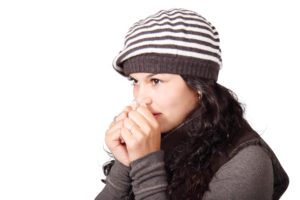December 31, 2018 | Black & Kletz Allergy

Symptoms based on the parts of the body:
Nose: The cold air of Winter can act as an irritant to anyone whether the individual has allergies or does not have allergies. The typical symptoms that may occur include runny nose, nasal congestion, post-nasal drip, and nosebleeds (i.e., epistaxis).
Patients with nonallergic rhinitis (i.e., vasomotor rhinitis) will experience these symptoms despite the fact that allergy testing is negative because these individuals are bothered by irritants such as cold air, cigarette smoke, air pollution, dusts, strong odors, chemicals, etc. Nosebleeds are usually a result of the cold dry air which is common during the Winter.
On the other hand, patients with allergic rhinitis (i.e., hay fever) can exhibit the same symptoms during the Winter as the patient with nonallergic rhinitis, however, their symptoms are generally due to a true allergy to allergens that are prevalent in the Winter months. The most common allergens during these months include dust mites, molds, pets, and cockroaches. Nosebleeds may be due to either a side effect of a corticosteroid nasal spray (e.g., Flonase, Nasacort, Rhinocort, Nasonex, Qnasl, Omnaris) used in the treatment of allergic rhinitis or the result of the cold dry air that accompanies the Winter weather.
Eyes: Similar to the effects that the cold air has on the nose, the cold air can affect ones’ eyes in very much the same way. The two characteristic symptoms exhibited when the eyes come in contact with cold air in an allergic or nonallergic individual include watery eyes and redness of the eyes. Itching of the eyes is generally not seen unless an individual is allergic and is reacting to one of the allergens common during the Winter (e.g., dust mites, molds, pets, cockroach).
Lungs: Cold air is a common trigger that exacerbates asthma symptoms (e.g., chest tightness, shortness of breath, wheezing, coughing) in asthmatic individuals. Most asthmatics have an underlying allergic diathesis and in turn their asthma may also be exacerbated by common Winter allergens such as molds, dust mites, pets, and/or cockroaches. Of note, cockroaches are a very common and potent allergen that aggravates the symptoms of asthma in asthmatic children living in inner cities. In nonallergic, non-asthmatic people, the cold air can also cause asthma-like symptoms, but generally the symptoms are milder in severity.
Skin: When the temperature drops in the Winter, the cold air can cause two similar conditions referred to as Raynaud’s disease (i.e., primary Raynaud’s) and Raynaud’s phenomenon (i.e., secondary Raynaud’s) depending on whether there is an underlying medical problem. Raynaud’s disease is not associated with another medical condition and is more common than Raynaud’s phenomenon which is associated with other medical conditions. The most common underlying medical problems that may be associated with Raynaud’s phenomenon may include connective tissue diseases (e.g., systemic lupus erythematosus, rheumatoid arthritis, scleroderma, Sjögren’s syndrome), smoking, atherosclerosis, carpal tunnel syndrome, injuries to the hands and/or feet, and certain medications (e.g., migraine headache medications, beta blockers, ADHD medications).
Regarding the skin, there are 4 conditions that all act on the skin and can be lumped into one entity as they are all very similar. The only difference between them is the severity of the reaction when an individual is exposed to the cold. The 4 conditions include cold-induced pruritus, cold-induced urticaria, cold-induced angioedema, and cold-induced anaphylaxis. In cold-induced pruritus, the cold air will cause a susceptible person to have itchy skin. In cold-induced urticaria, the individual will develop hives upon contact with something cold. People with cold-induced angioedema will develop swelling episodes when exposed to the cold. Lastly, some individuals may develop anaphylaxis when they are exposed to the cold which obviously can be very serious and potentially fatal. It is important to see a board certified allergist if you have one of these conditions, as a self-administered epinephrine device (e.g., EpiPen, Auvi-Q, Adrenaclick) is typically prescribed, particularly for cold-induced angioedema and cold-induced anaphylaxis. It is also important to note that any person who needs to use a self-administered epinephrine device should go immediately to the closest emergency room after using the device.
Winter is almost here and the temperatures outside have already begun to drop into the “cold” range. The board certified allergists at Black & Kletz Allergy have 3 locations in the Washington, Northern Virginia, and Maryland metropolitan area. We have offices in Washington, DC, McLean, VA (Tysons Corner, VA), and Manassas, VA. All 3 of our offices have on-site parking and the Washington, DC and McLean, VA offices are Metro accessible. The McLean office has a complementary shuttle that runs between our office and the Spring Hill metro station on the silver line. The allergy doctors of Black & Kletz Allergy diagnose and treat both pediatric and adult patients. For an appointment, please call our office or alternatively, you can click Request an Appointment and we will respond within 24 hours by the next business day. The allergy specialists at Black & Kletz Allergy have been helping patients with hay fever, asthma, sinus disease, hives, eczema, generalized itching, anaphylaxis, medication allergies, insect sting allergies, food allergies, and immunological disorders for more than 50 years. If you suffer from allergies, it is our mission to improve your quality of life by reducing or preventing your unwanted and aggravating allergy symptoms.












